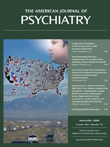In this issue of the
Journal, Gibbons and colleagues use pharmacy records and mortality data to examine the association between rates of antidepressant use and rates of suicide death in children and younger adolescents. They find that U.S. counties with higher rates of SSRI antidepressant use had lower rates of suicide death, and that this relationship persisted after accounting for potential confounding factors. This finding is consistent with two other observational studies
(1,
2) finding that increasing rates of antidepressant use among adolescents were accompanied by stable or declining suicide rates.
These findings seem to conflict with a meta-analysis of data from randomized placebo-controlled trials
(3) and with a recent case/control study
(4) . Using data from all placebo-controlled antidepressant trials in children and adolescents, Hammad and colleagues at the U.S. Food and Drug Administration (FDA) found that risk of suicidal ideation and suicidal behavior was nearly twice as high during treatment with several newer antidepressants compared with placebo
(3) . It is important to note that the number of actual suicide attempts in those placebo-controlled trials was too small to compare and that the number of suicide deaths was zero. Olfson and colleagues used a case/control design to examine the association between antidepressant use and suicide attempts in adolescents previously hospitalized for depression
(4) . Probability of antidepressant use was significantly greater in those attempting suicide after hospital discharge than in those not attempting suicide.
Data from adult antidepressant trials tell a somewhat different story. The combined population in placebo-controlled adult studies is nearly 50,000, or 10 times as large as that for studies of children and adolescents. Several meta-analyses of those adult studies found no significant difference (neither an increase nor a decrease) in risk of suicide attempt or suicide death in adults exposed to active antidepressants compared with those exposed to placebo
(5 –
7) .
Different findings in pediatric and adult studies are not the only source of complexity and potential confusion. Recent evidence suggests that effects on suicidality may differ across antidepressants. In the FDA meta-analysis of pediatric trials, risk ratios comparing individual drugs to placebo ranged from 1.4 to 5.5
(3) . Venlafaxine was the only individual drug for which the increase in risk was statistically significant
(3) . Two meta-analyses of adult paroxetine studies suggest an increased risk of suicidal behavior or suicide attempt
(8,
9) . One meta-analysis of adult sertraline studies found no increase in risk of suicidal ideation or behavior
(10) .
It is unlikely that additional randomized trials will provide a final answer to this question, either for adolescents or adults. A randomized trial to definitively determine whether a specific antidepressant increases or decreases risk of suicide death would need to include several hundred thousand patients. Such a study will never occur. Observational studies using computerized pharmacy data can include such large populations, but those studies are always subject to confounding or other biases. For example, the finding by Gibbons and colleagues that counties with higher antidepressant use tend to have lower suicide rates may simply mean that suicide rates are lower in areas with more progressive attitudes toward mental health care. Conversely, the finding by Olfson and colleagues
(4) that suicide attempters were more often using antidepressants than non-attempters may simply mean that use of antidepressants is a marker for more severe depression. Despite these limitations, observational studies can provide some reassurance. The risk of serious suicide attempt during the first 6 months of antidepressant treatment is less than 1 per 1,000 for adults and less than 1 in 300 for adolescents
(11) . Increasing use of newer antidepressants (compared across time or place) has been accompanied by lower rates of suicide mortality in adolescents and in adults
(1,
12) . Average risk of suicide attempt actually declines after starting antidepressant treatment
(11), but this more likely reflects the natural history of help-seeking than a protective effect of medication.
Finally, it is likely that effects of antidepressants on suicidal ideation or suicide risk differ across individuals. Most experienced clinicians have heard patients describe sudden onset of agitation and suicidal thoughts after starting antidepressants. The initial FDA advisory was motivated in part by numerous similar reports
(13,
14) . While these anecdotes cannot prove causation, they certainly suggest that some patients may be especially sensitive to this particular adverse effect. Even if randomized trials and large observational studies find no effect of antidepressants on average rates of suicide attempt or suicide death, average effects may not apply to all individuals.
This complexity raises many interesting questions for researchers, but it provides little clear guidance to physicians, patients, and family members. Caught between our concerns about precipitating a suicide attempt and our concerns about untreated depression, what advice can we give to those who are starting antidepressant treatment? Here is my best attempt to summarize the complex and sometimes conflicting evidence:
The Food and Drug Administration requires a warning that antidepressant medications can sometimes cause or increase thoughts of suicide. Studies in children and adolescents have shown that antidepressants can increase suicidal thoughts. However, other studies have shown that the overall risk of attempting suicide goes down after starting antidepressant medication. Even if antidepressants help most people who take them, some people may have very negative reactions. Thus, it is important that we have regular contact over the next few weeks. If you have thoughts about suicide or about harming yourself, please contact me right away.

